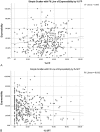Expressible Meibomian Glands Have Occult Fixed Obstructions: Findings From Meibomian Gland Probing to Restore Intraductal Integrity
- PMID: 30998615
- PMCID: PMC6571175
- DOI: 10.1097/ICO.0000000000001954
Expressible Meibomian Glands Have Occult Fixed Obstructions: Findings From Meibomian Gland Probing to Restore Intraductal Integrity
Abstract
Purpose: To describe and quantify findings of intraductal obstruction during probing expressible and nonexpressible meibomian glands (MGs) in patients with obstructive meibomian gland dysfunction using a 1-mm intraductal MG probe.
Methods: A retrospective study of probe findings from 108 consecutive patients. Nonparametric tests using SPSS software 25.0 to explore relationships between expressibility and probe findings.
Results: Of 11,776 probed glands of 404 lids, 84% showed mechanical resistance (MR) and 16% showed no resistance (NR). Fixed, firm, focal unyielding resistance (FFFUR) occurred in 79.5% of obstructed glands, and nonfixed, nonfocal easily yielding soft resistance (SFT) in 20.4%. FFFUR was characterized by an audible and tactile "firm pop" (FP) or "firm gritty" (FG) sensation. No significant difference in MR and FFFUR for lids between 0% and >90% gland expressibility was observed. FP correlated with increased expressibility (P = 0.011), lid tenderness (P = 0.045), and complete proximal obstruction (P = 0.037), whereas SFT correlated with reduced expressibility (P = 0.016). Upper lids showed greater incidence of MR (P < 0.001), FFFUR (P < 0.001), and FG (P < 0.001), whereas lower lids showed greater expressibility (P < 0.001) and NR (P < 0.001).
Conclusions: FFFUR was the most common probe finding in a large series of consecutively probed MGs, with an incidence of 67% of glands and 80% of obstructed glands. FFFUR was independent of gland expressibility, demonstrating expressible glands harbor FFFUR deep to at least one acinus. FP was associated with expressible gland occult obstruction and lid tenderness. SFT correlated with reduced expressibility, perhaps related to altered duct/duct contents. Upper lids correlated with increased MR, FFFUR, and FG and lower lids with increased expressibility and NR, possibly reflecting contrasting anatomy and blink-related microtrauma.
Figures



References
-
- Lemp MA, Crews LA, Bron AJ, et al. Distribution of aqueous-deficient and evaporative dry eye in a clinic-based patient cohort: a retrospective study. Cornea. 2012;31:472–478. - PubMed
-
- Finis D, Ackermann P, Pischel N, et al. Evaluation of Meibomian gland dysfunction and local distribution of Meibomian gland atrophy by non-contact infrared meibography. Curr Eye Res. 2015;40:982–989. - PubMed
-
- Foulks GN, Bron AJ. Meibomian gland dysfunction: a clinical scheme for description, diagnosis, classification, and grading. Ocul Surf. 2003;1:107–126. - PubMed
MeSH terms
LinkOut - more resources
Full Text Sources
Medical
Miscellaneous

